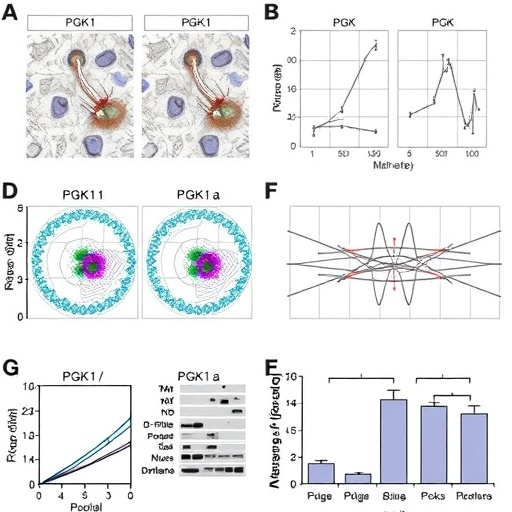Acute kidney injury (AKI) remains one of the most challenging complications in clinical medicine, carrying high morbidity and mortality rates, particularly in hospitalized patients. Recent research led by Zhu and colleagues has unveiled a novel molecular pathway that could revolutionize the way we approach treatment for AKI. This groundbreaking study highlights the role of phosphoglycerate kinase 1 (PGK1) and its downstream effects on cellular metabolism and ferroptotic cell death—a discovery that signals a paradigm shift in nephrology and cell death biology.
The research team focused on the relationship between PGK1 and acute kidney damage, meticulously delineating the molecular cascade that connects metabolic enzymes to ferroptosis, a form of programmed cell death characterized by iron-dependent lipid peroxidation. Ferroptosis has emerged in recent years as a critical mechanism underpinning organ ischemia-reperfusion injury and other pathological insults. Understanding how PGK1 inhibition intersects this pathway offers new hope for therapeutic intervention.
PGK1 is traditionally known as a key glycolytic enzyme, catalyzing the conversion of 1,3-bisphosphoglycerate to 3-phosphoglycerate, generating ATP in the process. However, Zhu et al. discovered that aside from its metabolic function, PGK1 serves as a regulatory hub that influences the activity of pyruvate kinase M2 (PKM2), an isoform implicated in metabolic reprogramming in stressed or injured tissues. The inhibition of PGK1 was found to inactivate PKM2, setting off a cascade that ultimately modulates the activity of arachidonate 12-lipoxygenase (ALOX12), a critical enzyme in lipid peroxidation.
This intricate pathway is pivotal because ALOX12 catalyzes the oxidation of polyunsaturated fatty acids in cell membranes, a key step in the execution of ferroptosis. By suppressing PGK1, the researchers effectively blocked the PKM2/ALOX12 axis, thereby diminishing lipid peroxidation and protecting renal tubular cells from ferroptotic death. This was confirmed through rigorous in vivo studies using male mice models of acute kidney injury.
The choice of male mice was intentional, driven by the need to control for sex-specific differences in renal pathology and ferroptosis susceptibility. Notably, the intervention led to marked preservation of kidney function, reduced histological damage, and decreased levels of renal biomarkers indicative of injury. These findings underscore the therapeutic potential of targeting metabolic pathways to mitigate ferroptosis in AKI.
Zhu and colleagues employed an array of molecular biology techniques to substantiate their findings, including Western blotting, immunohistochemistry, and mass spectrometry-based lipidomics. These methods elucidated the suppression of PGK1 expression and the downstream effects on PKM2 phosphorylation status, revealing a tight regulatory network that governs ferroptotic cell death. Lipidomic profiling demonstrated reduced accumulation of oxidized phospholipids, providing biochemical evidence of attenuated ferroptosis.
The significance of this study extends beyond the kidney. Because ferroptosis has been implicated in multiple diseases ranging from neurodegeneration to cancer, the identification of PGK1 as a modulator of this pathway presents a broad spectrum of translational opportunities. Pharmacological agents or gene therapies designed to inhibit PGK1 could serve as powerful tools to curb ferroptosis-driven damage in diverse tissues.
In clinical contexts, AKI manifests as a rapid deterioration of renal function and contributes to the progression of chronic kidney disease if left unchecked. Currently, treatment options remain largely supportive, including fluid management and dialysis, with no approved agents that directly target the underlying molecular mechanisms of injury. The research by Zhu et al. paves the way for innovative therapeutics that can precisely dial down ferroptosis and preserve renal architecture and function.
Another exciting aspect of the study was the demonstration of reversibility. The team showed that pharmacological inhibitors of PGK1 administered after injury onset could still provide renoprotection, highlighting a therapeutic window that is clinically relevant. This finding heightens the translational relevance of their work, as it supports the feasibility of treating AKI even after diagnosis.
Mechanistically, the study illuminated how metabolic remodeling during AKI exacerbates oxidative stress and lipid peroxidation. PGK1 inhibition appears to recalibrate energy metabolism, reducing the overactivation of PKM2 and preventing the lethal accumulation of lipid hydroperoxides catalyzed by ALOX12. This delicate balance between metabolism and redox biology calls for further exploration to optimize targeted interventions.
One of the more intriguing discoveries was the interplay between PGK1 and PKM2 outside their canonical roles in metabolism. The notion that metabolic enzymes also serve as signaling molecules adds complexity but also therapeutic leverage. By targeting PGK1, researchers can indirectly modulate pyroptotic signals, leading to an integrated approach that disrupts crosstalk between metabolism and cell death.
The implications of this work extend into personalized medicine. Identification of biomarkers linked to PGK1 activity and ferroptosis could enable risk stratification and targeted treatment of patients prone to AKI, such as those undergoing major surgery, sepsis, or nephrotoxic drug exposure. This precision approach would improve outcomes and reduce healthcare burdens globally.
Future studies are warranted to explore the long-term effects of PGK1 modulation and to validate these findings in human tissues. Although the mouse model provides compelling evidence, translation to human clinical settings requires extensive safety and efficacy testing. Importantly, sex differences and comorbidities must be factored into subsequent research to ensure robust applications.
In conclusion, the work by Zhu et al. represents a monumental advance in understanding acute kidney injury by unmasking a previously underappreciated metabolic nexus that controls ferroptosis. Targeting PGK1 to dampen the PKM2/ALOX12 pathway provides a novel—and practical—therapeutic avenue to prevent or ameliorate AKI. This study not only opens new doors in nephrology but also enriches our broader comprehension of ferroptotic mechanisms in disease. As clinicians and researchers eagerly anticipate future developments, this discovery propels us toward a future where metabolic reprogramming could safeguard kidney health against the ravages of acute injury.
Subject of Research: Acute kidney injury and molecular mechanisms involving metabolism and ferroptosis
Article Title: Inhibition of PGK1 ameliorates acute kidney injury through inactivating the PKM2/ALOX12/ferroptosis pathway in a study with male mice
Article References:
Zhu, XX., Meng, XY., Zhang, AY. et al. Inhibition of PGK1 ameliorates acute kidney injury through inactivating the PKM2/ALOX12/ferroptosis pathway in a study with male mice. Nat Commun 16, 9436 (2025). https://doi.org/10.1038/s41467-025-64480-1
Image Credits: AI Generated




